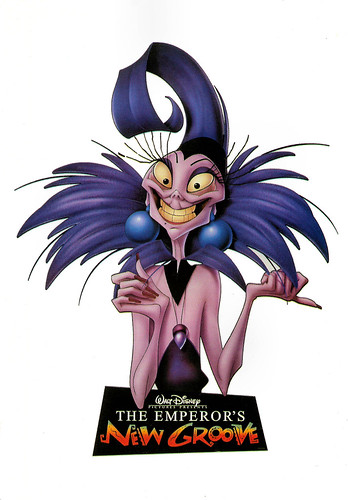
Vintage postcard in the Cinemascope Collection, no. 500. Image: Walt Disney Pictures. Image of Yzma for The Emperor's New Groove (Mark Dindal, 2000).
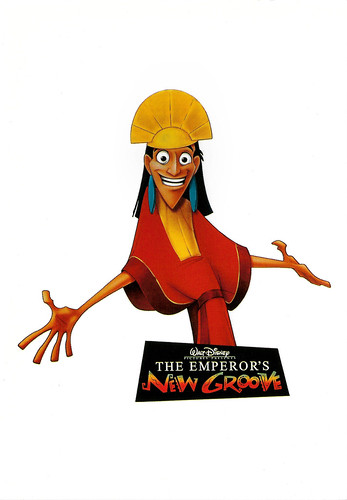
Vintage postcard in the Cinemascope Collection, no. 501. Image: Walt Disney Pictures. Image of Kuzco for The Emperor's New Groove (Mark Dindal, 2000).
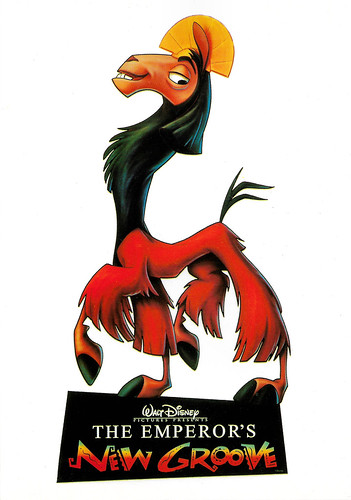
Vintage postcard in the Cinemascope Collection, no. 502. Image: Walt Disney Pictures. Image of Kuzco for The Emperor's New Groove (Mark Dindal, 2000).
A llama mourning in the pouring rain
The beginning of The Emperor's New Groove (Mark Dindal, 2000) shows a llama mourning in the jungle at night in the pouring rain. The llama reveals itself as the Kuzco, the 18-year-old arrogant and self-absorbed king of the Inca kingdom, who has been transformed into a llama.
Kuzco tells the viewer his backstory in a flashback. As an emperor, he was a very busy man who routinely punished anyone who disappointed him or "ruined his groove".
When he receives Patcha, a friendly farmer and village chief, he tells him that he plans to demolish his village to build himself a lavish summer holiday resort called "Kuzcotopia" just for himself for his birthday. This news leaves Patcha angry and desperate.
When Kuzco later fires his conniving advisor Yzma, she and the bumbling Kronk plot to take over the throne. The duo attempt to poison the king over dinner, but due to a mix-up with the labelling on Yzma's flask, they accidentally give him a potion that turns him into a llama. When the two beat Kuzco unconscious and put him in a sack, Yzma orders Kronk to kill him.
However, Kronk feels remorse and saves him, but loses the sack containing Kuzco, which lands on Patcha's wagon. Upon discovering the llama's true self, Pacha offers to help resolve the Emperor's problem and regain his throne, only if he promises to move his water park.
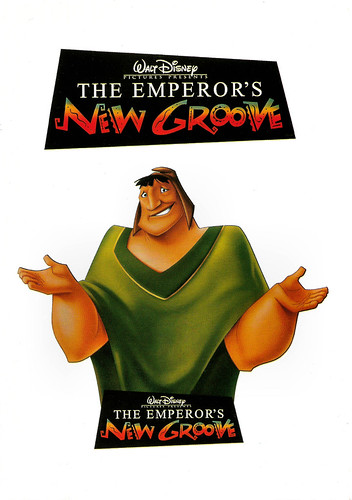
Vintage postcard in the Cinemascope Collection, no. 503. Image: Walt Disney Pictures. Image of Patcha for The Emperor's New Groove (Mark Dindal, 2000).
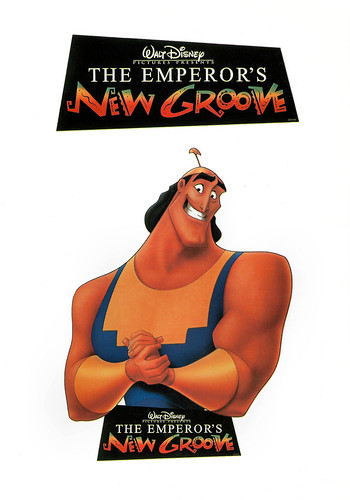
Vintage postcard in the Cinemascope Collection, no. 504. Image: Walt Disney Pictures. Image of Kronk for The Emperor's New Groove (Mark Dindal, 2000).
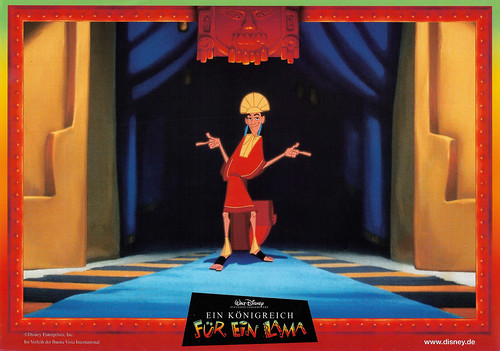
German lobby card by Buena Vista International. Image: Disney Enterprises Inc. Publicity still for The Emperor's New Groove (Mark Dindal, 2000). The German title was Ein Königreich für ein Lama.
A dramatic, sweeping Disney musical
The Emperor's New Groove (Mark Dindal, 2000) was originally planned to be a dramatic, sweeping Disney musical named 'Kingdom of the Sun', to be directed by Roger Allers, director of The Lion King (1994). Sting had written six original songs.
The film was essentially an Incan re-telling of Mark Twain's 'The Prince and the Pauper'. As Roger Allers's take on the movie was starting to take shape, Disney management was becoming increasingly uncomfortable with the movie, feeling it was too similar to the story of 'The Prince and the Pauper'. Test screenings generated poor feedback.
The production was suspended, even though the film was fifty per cent complete. Also because of the underwhelming box-office performances of Pocahontas (1995) and The Hunchback of Notre Dame (1996), Mark Dindal, director of Turner's Cats Don't Dance (1997), was brought in as co-director to add more comedic elements to the film.
Supervising animator Andreas Deja left the project and moved to Orlando, Florida to work on Lilo & Stitch (2002). Dindal and Allers did not get along and essentially both began making their separate versions of the film.
The Disney executives, although unhappy with Roger Allers's direction on the film held off from interfering with him, given that he had provided them with their biggest hit, The Lion King (1994), which too had had a troubled production. Also, most of Allers' crew were very loyal to their director.
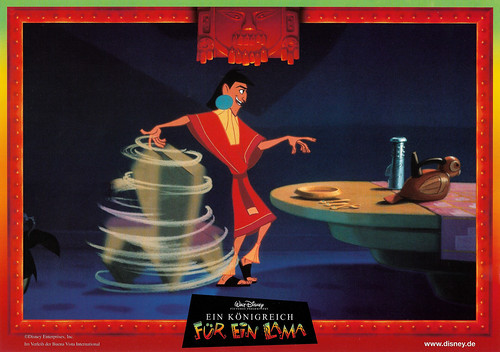
German lobby card by Buena Vista International. Image: Disney Enterprises Inc. Publicity still for The Emperor's New Groove (Mark Dindal, 2000). The German title was Ein Königreich für ein Lama.
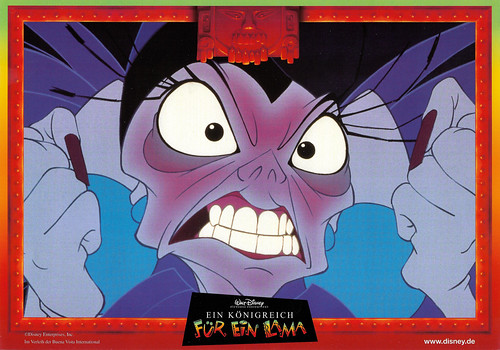
German lobby card by Buena Vista International. Image: Disney Enterprises Inc. Publicity still for The Emperor's New Groove (Mark Dindal, 2000). The German title was Ein Königreich für ein Lama.
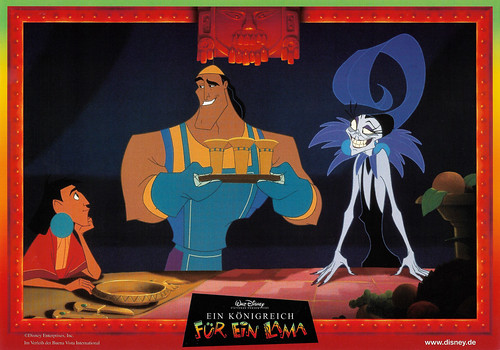
German lobby card by Buena Vista International. Image: Disney Enterprises Inc. Publicity still for The Emperor's New Groove (Mark Dindal, 2000). The German title was Ein Königreich für ein Lama.
A new, wackier film
By the summer of 1998, it was increasingly clear that Kingdom of the Sun was not going to make its summer 2000 release date. Merchandising tie-ins with McDonald's and Coca-Cola amongst others meant that the release date could not be moved. Director Roger Allers asked for a six-month extension to the release which was denied. Allers then quit the project.
With the film on the brink of total shutdown, co-director Mark Dindal worked on a retooling of the film. While he did this, most of his animators were reassigned to work on the Rhapsody in Blue segment of Fantasia 2000 (1999).
During the production hiatus, Dindal, producer Randy Fullmer, storyman Chris Williams, and screenwriter David Reynolds completely overhauled the film, eventually throwing out the 'Prince and the Pauper' angle, the completed footage, and all but one of Sting's songs. The story was rebuilt from the ground up and Dindal created a new, wackier film that centred around the (talking) llama, Yzma, and two new characters: Pacha, and Kronk.
A documentary, The Sweatbox (2002), details the production troubles that The Emperor's New Groove endured during its six years of development. In 2000, The Emperor's New Groove received generally positive reactions but performed disappointingly at the box office compared to Disney films released in the 1990s, grossing $169.5 million on a $100-million budget.
However, the film found larger success when it was released for home media, and became the best-selling DVD of 2001. In the years since its release, The Emperor's New Groove garnered a cult following among fans. In 2005, there was a sequel or spin-off, the direct-to-video animated musical Kronk's New Groove (Elliot M. Bour, Saul Andrew Blinkoff, 2005).
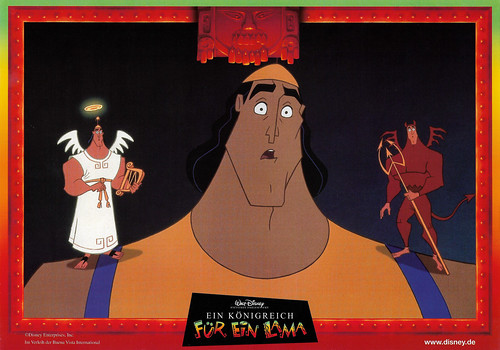
German lobby card by Buena Vista International. Image: Disney Enterprises Inc. Publicity still for The Emperor's New Groove (Mark Dindal, 2000). The German title was Ein Königreich für ein Lama.

German lobby card by Buena Vista International. Image: Disney Enterprises Inc. Publicity still for The Emperor's New Groove (Mark Dindal, 2000). The German title was Ein Königreich für ein Lama.
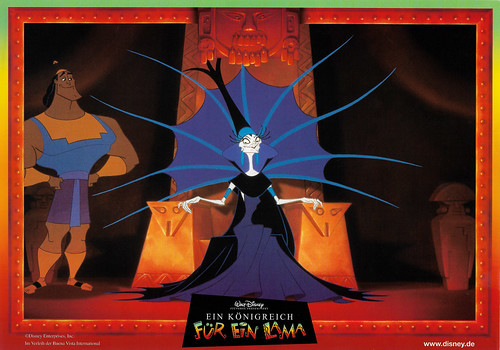
German lobby card by Buena Vista International. Image: Disney Enterprises Inc. Publicity still for The Emperor's New Groove (Mark Dindal, 2000). The German title was Ein Königreich für ein Lama.

German lobby card by Buena Vista International. Image: Disney Enterprises Inc. Publicity still for The Emperor's New Groove (Mark Dindal, 2000). The German title was Ein Königreich für ein Lama.
Sources: Wikipedia (English, Dutch and German) and IMDb.
No comments:
Post a Comment